Future of Renewable Energy in the UK Construction Sector Dissertation
VerifiedAdded on 2022/09/23
|57
|17504
|18
Project
AI Summary
This dissertation explores the future of renewable energy in the UK, particularly within the construction sector. It begins by examining the global context of climate change and the UK's approach to tackling it, including relevant legislation like the Climate Change Act 2008. A comprehensive literature review covers sustainable construction practices, the impact of the construction industry on the environment, and various renewable energy sources such as wind, biomass, and hydropower. The analysis delves into policy and regulatory frameworks, including the Renewable Obligation and feed-in tariffs, as well as regional planning guidelines. The dissertation also includes a SWOT analysis and proposes further research directions, culminating in conclusions and recommendations for the advancement of renewable energy in the UK construction sector. The research examines the impact of the construction sector and the global efforts to decarbonize and mitigate climate change. The document covers a wide range of topics including sustainable construction, renewable energy sources, and policy and regulatory frameworks. It is a comprehensive review of the current state and future prospects of renewable energy in the UK.
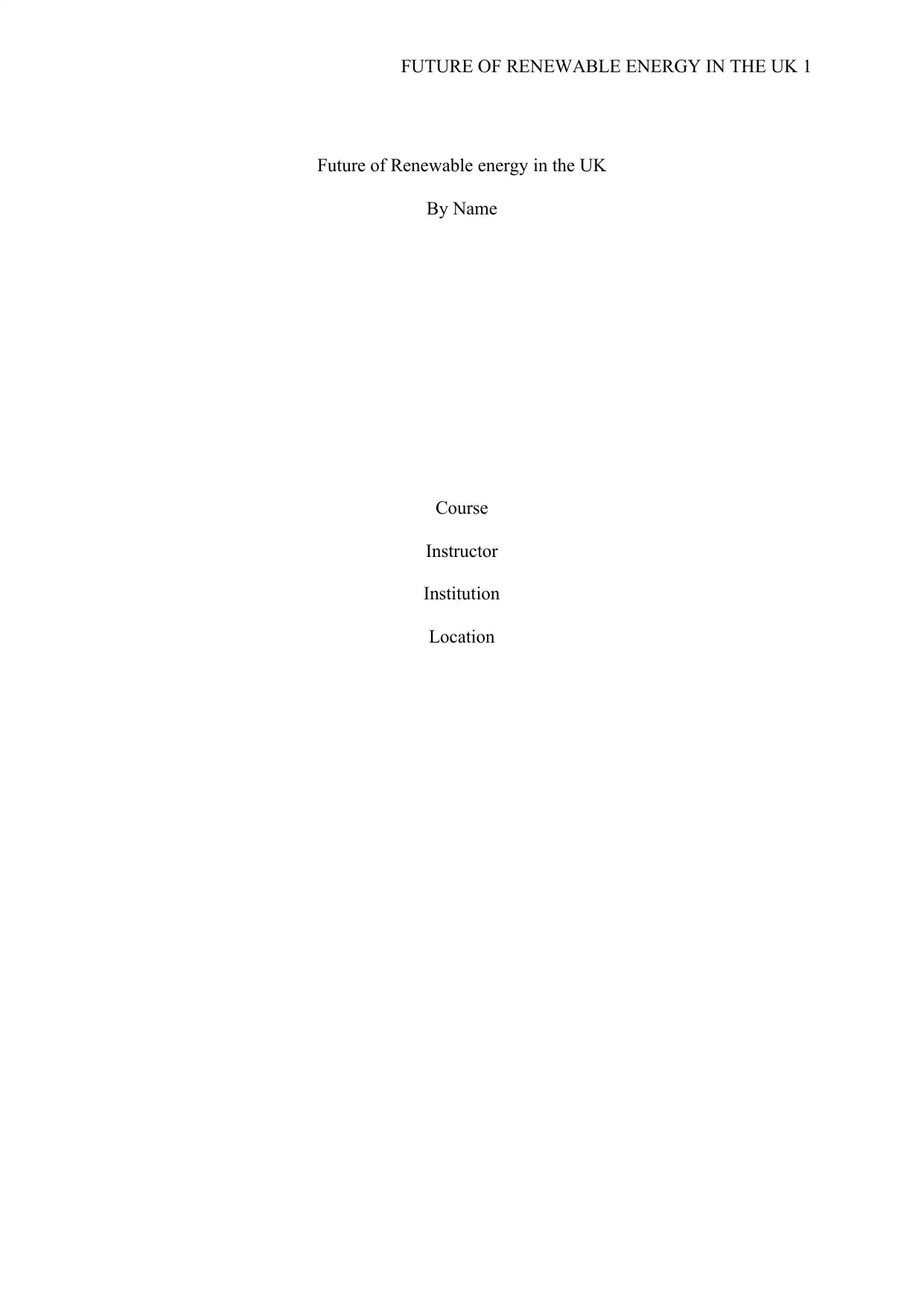
FUTURE OF RENEWABLE ENERGY IN THE UK 1
Future of Renewable energy in the UK
By Name
Course
Instructor
Institution
Location
Future of Renewable energy in the UK
By Name
Course
Instructor
Institution
Location
Paraphrase This Document
Need a fresh take? Get an instant paraphrase of this document with our AI Paraphraser
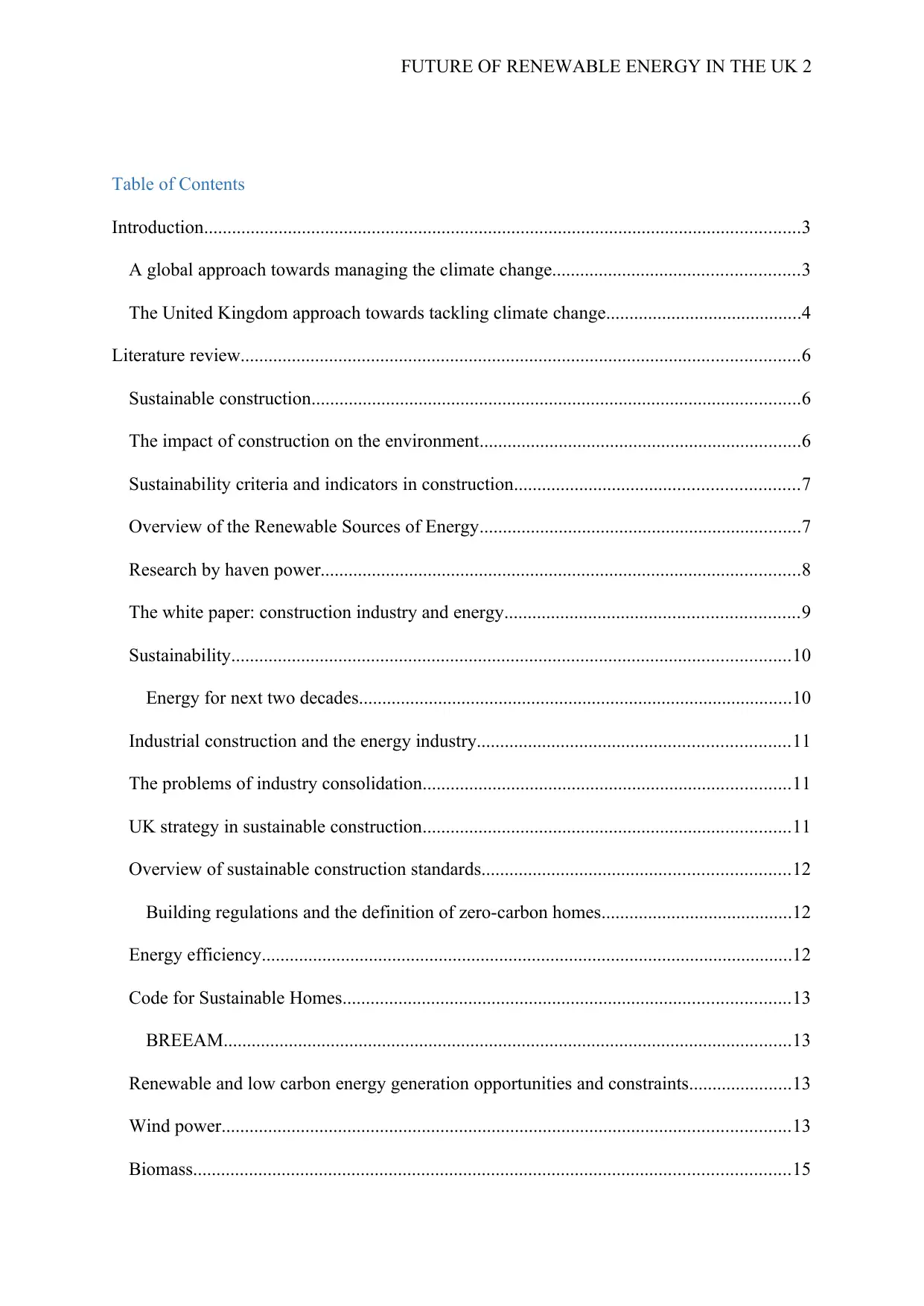
FUTURE OF RENEWABLE ENERGY IN THE UK 2
Table of Contents
Introduction................................................................................................................................3
A global approach towards managing the climate change.....................................................3
The United Kingdom approach towards tackling climate change..........................................4
Literature review........................................................................................................................6
Sustainable construction.........................................................................................................6
The impact of construction on the environment.....................................................................6
Sustainability criteria and indicators in construction.............................................................7
Overview of the Renewable Sources of Energy.....................................................................7
Research by haven power.......................................................................................................8
The white paper: construction industry and energy...............................................................9
Sustainability........................................................................................................................10
Energy for next two decades.............................................................................................10
Industrial construction and the energy industry...................................................................11
The problems of industry consolidation...............................................................................11
UK strategy in sustainable construction...............................................................................11
Overview of sustainable construction standards..................................................................12
Building regulations and the definition of zero-carbon homes.........................................12
Energy efficiency..................................................................................................................12
Code for Sustainable Homes................................................................................................13
BREEAM..........................................................................................................................13
Renewable and low carbon energy generation opportunities and constraints......................13
Wind power..........................................................................................................................13
Biomass................................................................................................................................15
Table of Contents
Introduction................................................................................................................................3
A global approach towards managing the climate change.....................................................3
The United Kingdom approach towards tackling climate change..........................................4
Literature review........................................................................................................................6
Sustainable construction.........................................................................................................6
The impact of construction on the environment.....................................................................6
Sustainability criteria and indicators in construction.............................................................7
Overview of the Renewable Sources of Energy.....................................................................7
Research by haven power.......................................................................................................8
The white paper: construction industry and energy...............................................................9
Sustainability........................................................................................................................10
Energy for next two decades.............................................................................................10
Industrial construction and the energy industry...................................................................11
The problems of industry consolidation...............................................................................11
UK strategy in sustainable construction...............................................................................11
Overview of sustainable construction standards..................................................................12
Building regulations and the definition of zero-carbon homes.........................................12
Energy efficiency..................................................................................................................12
Code for Sustainable Homes................................................................................................13
BREEAM..........................................................................................................................13
Renewable and low carbon energy generation opportunities and constraints......................13
Wind power..........................................................................................................................13
Biomass................................................................................................................................15
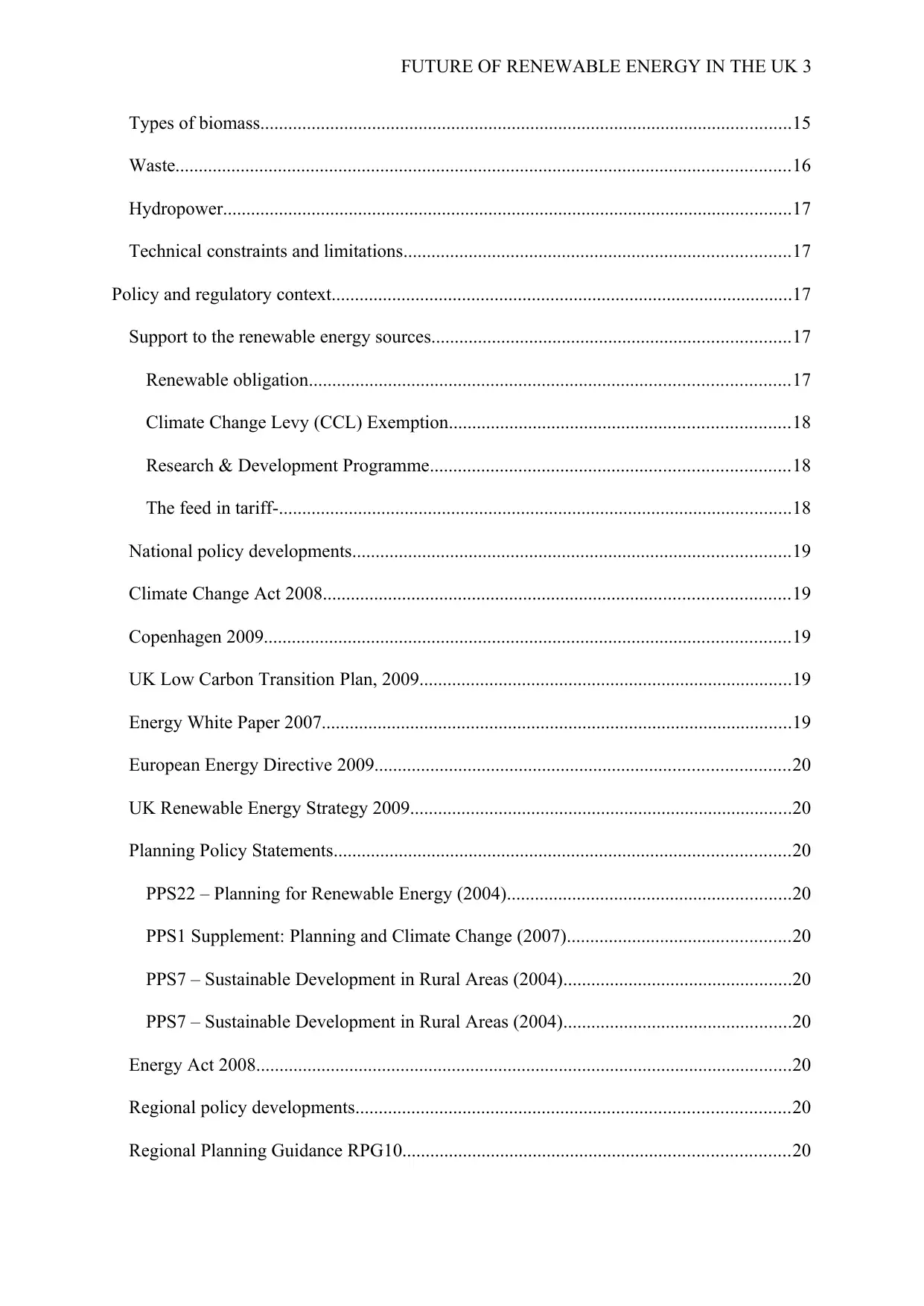
FUTURE OF RENEWABLE ENERGY IN THE UK 3
Types of biomass..................................................................................................................15
Waste....................................................................................................................................16
Hydropower..........................................................................................................................17
Technical constraints and limitations...................................................................................17
Policy and regulatory context...................................................................................................17
Support to the renewable energy sources.............................................................................17
Renewable obligation.......................................................................................................17
Climate Change Levy (CCL) Exemption.........................................................................18
Research & Development Programme.............................................................................18
The feed in tariff-..............................................................................................................18
National policy developments..............................................................................................19
Climate Change Act 2008....................................................................................................19
Copenhagen 2009.................................................................................................................19
UK Low Carbon Transition Plan, 2009................................................................................19
Energy White Paper 2007.....................................................................................................19
European Energy Directive 2009.........................................................................................20
UK Renewable Energy Strategy 2009..................................................................................20
Planning Policy Statements..................................................................................................20
PPS22 – Planning for Renewable Energy (2004).............................................................20
PPS1 Supplement: Planning and Climate Change (2007)................................................20
PPS7 – Sustainable Development in Rural Areas (2004).................................................20
PPS7 – Sustainable Development in Rural Areas (2004).................................................20
Energy Act 2008...................................................................................................................20
Regional policy developments.............................................................................................20
Regional Planning Guidance RPG10...................................................................................20
Types of biomass..................................................................................................................15
Waste....................................................................................................................................16
Hydropower..........................................................................................................................17
Technical constraints and limitations...................................................................................17
Policy and regulatory context...................................................................................................17
Support to the renewable energy sources.............................................................................17
Renewable obligation.......................................................................................................17
Climate Change Levy (CCL) Exemption.........................................................................18
Research & Development Programme.............................................................................18
The feed in tariff-..............................................................................................................18
National policy developments..............................................................................................19
Climate Change Act 2008....................................................................................................19
Copenhagen 2009.................................................................................................................19
UK Low Carbon Transition Plan, 2009................................................................................19
Energy White Paper 2007.....................................................................................................19
European Energy Directive 2009.........................................................................................20
UK Renewable Energy Strategy 2009..................................................................................20
Planning Policy Statements..................................................................................................20
PPS22 – Planning for Renewable Energy (2004).............................................................20
PPS1 Supplement: Planning and Climate Change (2007)................................................20
PPS7 – Sustainable Development in Rural Areas (2004).................................................20
PPS7 – Sustainable Development in Rural Areas (2004).................................................20
Energy Act 2008...................................................................................................................20
Regional policy developments.............................................................................................20
Regional Planning Guidance RPG10...................................................................................20
⊘ This is a preview!⊘
Do you want full access?
Subscribe today to unlock all pages.

Trusted by 1+ million students worldwide

FUTURE OF RENEWABLE ENERGY IN THE UK 4
Analysis....................................................................................................................................22
A brief review of environmental assessment methods.........................................................22
Reflection on the recent policy in sustainable construction.................................................23
Swot analysis........................................................................................................................23
Further research........................................................................................................................24
Conclusion................................................................................................................................25
Analysis....................................................................................................................................22
A brief review of environmental assessment methods.........................................................22
Reflection on the recent policy in sustainable construction.................................................23
Swot analysis........................................................................................................................23
Further research........................................................................................................................24
Conclusion................................................................................................................................25
Paraphrase This Document
Need a fresh take? Get an instant paraphrase of this document with our AI Paraphraser
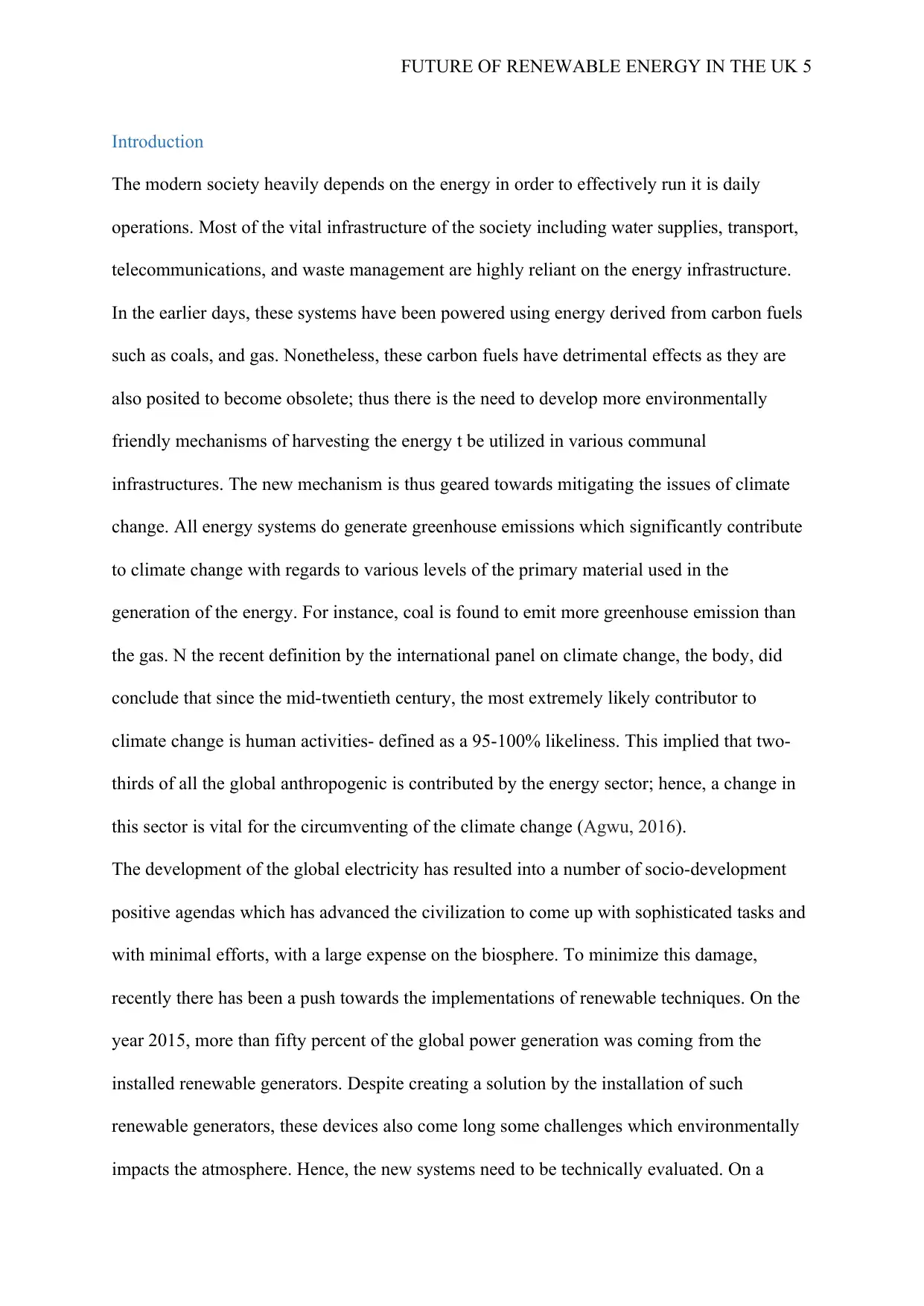
FUTURE OF RENEWABLE ENERGY IN THE UK 5
Introduction
The modern society heavily depends on the energy in order to effectively run it is daily
operations. Most of the vital infrastructure of the society including water supplies, transport,
telecommunications, and waste management are highly reliant on the energy infrastructure.
In the earlier days, these systems have been powered using energy derived from carbon fuels
such as coals, and gas. Nonetheless, these carbon fuels have detrimental effects as they are
also posited to become obsolete; thus there is the need to develop more environmentally
friendly mechanisms of harvesting the energy t be utilized in various communal
infrastructures. The new mechanism is thus geared towards mitigating the issues of climate
change. All energy systems do generate greenhouse emissions which significantly contribute
to climate change with regards to various levels of the primary material used in the
generation of the energy. For instance, coal is found to emit more greenhouse emission than
the gas. N the recent definition by the international panel on climate change, the body, did
conclude that since the mid-twentieth century, the most extremely likely contributor to
climate change is human activities- defined as a 95-100% likeliness. This implied that two-
thirds of all the global anthropogenic is contributed by the energy sector; hence, a change in
this sector is vital for the circumventing of the climate change (Agwu, 2016).
The development of the global electricity has resulted into a number of socio-development
positive agendas which has advanced the civilization to come up with sophisticated tasks and
with minimal efforts, with a large expense on the biosphere. To minimize this damage,
recently there has been a push towards the implementations of renewable techniques. On the
year 2015, more than fifty percent of the global power generation was coming from the
installed renewable generators. Despite creating a solution by the installation of such
renewable generators, these devices also come long some challenges which environmentally
impacts the atmosphere. Hence, the new systems need to be technically evaluated. On a
Introduction
The modern society heavily depends on the energy in order to effectively run it is daily
operations. Most of the vital infrastructure of the society including water supplies, transport,
telecommunications, and waste management are highly reliant on the energy infrastructure.
In the earlier days, these systems have been powered using energy derived from carbon fuels
such as coals, and gas. Nonetheless, these carbon fuels have detrimental effects as they are
also posited to become obsolete; thus there is the need to develop more environmentally
friendly mechanisms of harvesting the energy t be utilized in various communal
infrastructures. The new mechanism is thus geared towards mitigating the issues of climate
change. All energy systems do generate greenhouse emissions which significantly contribute
to climate change with regards to various levels of the primary material used in the
generation of the energy. For instance, coal is found to emit more greenhouse emission than
the gas. N the recent definition by the international panel on climate change, the body, did
conclude that since the mid-twentieth century, the most extremely likely contributor to
climate change is human activities- defined as a 95-100% likeliness. This implied that two-
thirds of all the global anthropogenic is contributed by the energy sector; hence, a change in
this sector is vital for the circumventing of the climate change (Agwu, 2016).
The development of the global electricity has resulted into a number of socio-development
positive agendas which has advanced the civilization to come up with sophisticated tasks and
with minimal efforts, with a large expense on the biosphere. To minimize this damage,
recently there has been a push towards the implementations of renewable techniques. On the
year 2015, more than fifty percent of the global power generation was coming from the
installed renewable generators. Despite creating a solution by the installation of such
renewable generators, these devices also come long some challenges which environmentally
impacts the atmosphere. Hence, the new systems need to be technically evaluated. On a
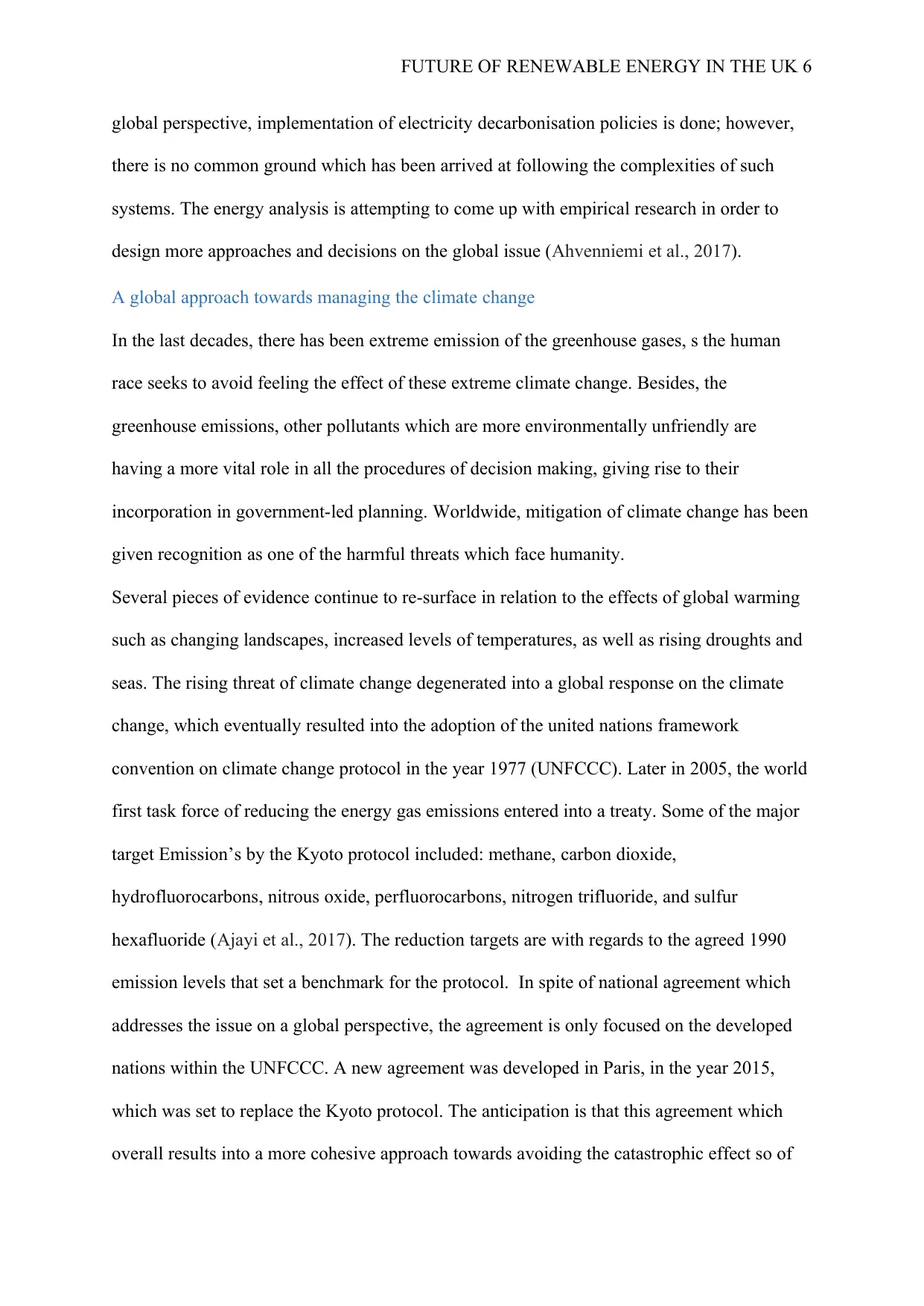
FUTURE OF RENEWABLE ENERGY IN THE UK 6
global perspective, implementation of electricity decarbonisation policies is done; however,
there is no common ground which has been arrived at following the complexities of such
systems. The energy analysis is attempting to come up with empirical research in order to
design more approaches and decisions on the global issue (Ahvenniemi et al., 2017).
A global approach towards managing the climate change
In the last decades, there has been extreme emission of the greenhouse gases, s the human
race seeks to avoid feeling the effect of these extreme climate change. Besides, the
greenhouse emissions, other pollutants which are more environmentally unfriendly are
having a more vital role in all the procedures of decision making, giving rise to their
incorporation in government-led planning. Worldwide, mitigation of climate change has been
given recognition as one of the harmful threats which face humanity.
Several pieces of evidence continue to re-surface in relation to the effects of global warming
such as changing landscapes, increased levels of temperatures, as well as rising droughts and
seas. The rising threat of climate change degenerated into a global response on the climate
change, which eventually resulted into the adoption of the united nations framework
convention on climate change protocol in the year 1977 (UNFCCC). Later in 2005, the world
first task force of reducing the energy gas emissions entered into a treaty. Some of the major
target Emission’s by the Kyoto protocol included: methane, carbon dioxide,
hydrofluorocarbons, nitrous oxide, perfluorocarbons, nitrogen trifluoride, and sulfur
hexafluoride (Ajayi et al., 2017). The reduction targets are with regards to the agreed 1990
emission levels that set a benchmark for the protocol. In spite of national agreement which
addresses the issue on a global perspective, the agreement is only focused on the developed
nations within the UNFCCC. A new agreement was developed in Paris, in the year 2015,
which was set to replace the Kyoto protocol. The anticipation is that this agreement which
overall results into a more cohesive approach towards avoiding the catastrophic effect so of
global perspective, implementation of electricity decarbonisation policies is done; however,
there is no common ground which has been arrived at following the complexities of such
systems. The energy analysis is attempting to come up with empirical research in order to
design more approaches and decisions on the global issue (Ahvenniemi et al., 2017).
A global approach towards managing the climate change
In the last decades, there has been extreme emission of the greenhouse gases, s the human
race seeks to avoid feeling the effect of these extreme climate change. Besides, the
greenhouse emissions, other pollutants which are more environmentally unfriendly are
having a more vital role in all the procedures of decision making, giving rise to their
incorporation in government-led planning. Worldwide, mitigation of climate change has been
given recognition as one of the harmful threats which face humanity.
Several pieces of evidence continue to re-surface in relation to the effects of global warming
such as changing landscapes, increased levels of temperatures, as well as rising droughts and
seas. The rising threat of climate change degenerated into a global response on the climate
change, which eventually resulted into the adoption of the united nations framework
convention on climate change protocol in the year 1977 (UNFCCC). Later in 2005, the world
first task force of reducing the energy gas emissions entered into a treaty. Some of the major
target Emission’s by the Kyoto protocol included: methane, carbon dioxide,
hydrofluorocarbons, nitrous oxide, perfluorocarbons, nitrogen trifluoride, and sulfur
hexafluoride (Ajayi et al., 2017). The reduction targets are with regards to the agreed 1990
emission levels that set a benchmark for the protocol. In spite of national agreement which
addresses the issue on a global perspective, the agreement is only focused on the developed
nations within the UNFCCC. A new agreement was developed in Paris, in the year 2015,
which was set to replace the Kyoto protocol. The anticipation is that this agreement which
overall results into a more cohesive approach towards avoiding the catastrophic effect so of
⊘ This is a preview!⊘
Do you want full access?
Subscribe today to unlock all pages.

Trusted by 1+ million students worldwide
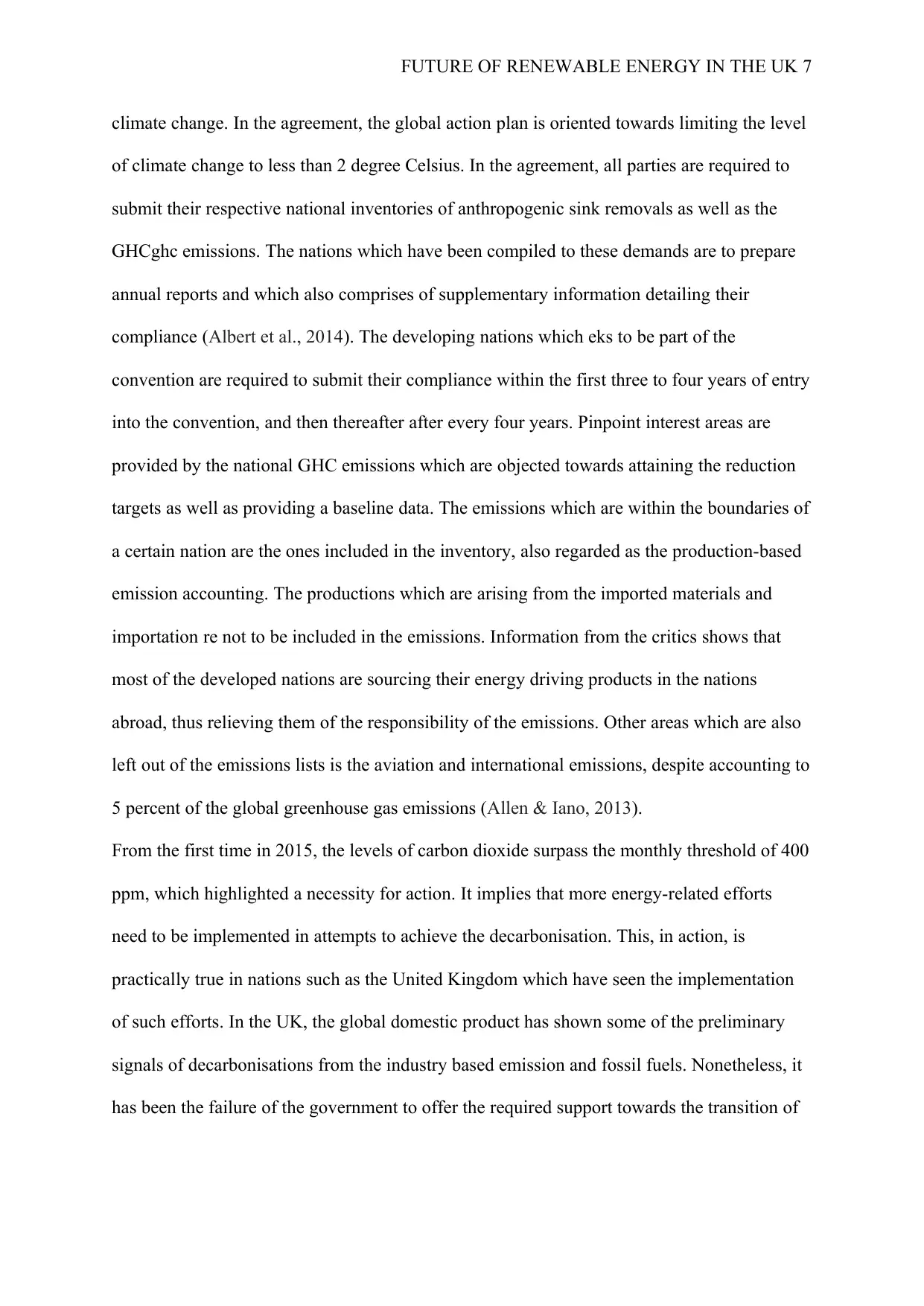
FUTURE OF RENEWABLE ENERGY IN THE UK 7
climate change. In the agreement, the global action plan is oriented towards limiting the level
of climate change to less than 2 degree Celsius. In the agreement, all parties are required to
submit their respective national inventories of anthropogenic sink removals as well as the
GHCghc emissions. The nations which have been compiled to these demands are to prepare
annual reports and which also comprises of supplementary information detailing their
compliance (Albert et al., 2014). The developing nations which eks to be part of the
convention are required to submit their compliance within the first three to four years of entry
into the convention, and then thereafter after every four years. Pinpoint interest areas are
provided by the national GHC emissions which are objected towards attaining the reduction
targets as well as providing a baseline data. The emissions which are within the boundaries of
a certain nation are the ones included in the inventory, also regarded as the production-based
emission accounting. The productions which are arising from the imported materials and
importation re not to be included in the emissions. Information from the critics shows that
most of the developed nations are sourcing their energy driving products in the nations
abroad, thus relieving them of the responsibility of the emissions. Other areas which are also
left out of the emissions lists is the aviation and international emissions, despite accounting to
5 percent of the global greenhouse gas emissions (Allen & Iano, 2013).
From the first time in 2015, the levels of carbon dioxide surpass the monthly threshold of 400
ppm, which highlighted a necessity for action. It implies that more energy-related efforts
need to be implemented in attempts to achieve the decarbonisation. This, in action, is
practically true in nations such as the United Kingdom which have seen the implementation
of such efforts. In the UK, the global domestic product has shown some of the preliminary
signals of decarbonisations from the industry based emission and fossil fuels. Nonetheless, it
has been the failure of the government to offer the required support towards the transition of
climate change. In the agreement, the global action plan is oriented towards limiting the level
of climate change to less than 2 degree Celsius. In the agreement, all parties are required to
submit their respective national inventories of anthropogenic sink removals as well as the
GHCghc emissions. The nations which have been compiled to these demands are to prepare
annual reports and which also comprises of supplementary information detailing their
compliance (Albert et al., 2014). The developing nations which eks to be part of the
convention are required to submit their compliance within the first three to four years of entry
into the convention, and then thereafter after every four years. Pinpoint interest areas are
provided by the national GHC emissions which are objected towards attaining the reduction
targets as well as providing a baseline data. The emissions which are within the boundaries of
a certain nation are the ones included in the inventory, also regarded as the production-based
emission accounting. The productions which are arising from the imported materials and
importation re not to be included in the emissions. Information from the critics shows that
most of the developed nations are sourcing their energy driving products in the nations
abroad, thus relieving them of the responsibility of the emissions. Other areas which are also
left out of the emissions lists is the aviation and international emissions, despite accounting to
5 percent of the global greenhouse gas emissions (Allen & Iano, 2013).
From the first time in 2015, the levels of carbon dioxide surpass the monthly threshold of 400
ppm, which highlighted a necessity for action. It implies that more energy-related efforts
need to be implemented in attempts to achieve the decarbonisation. This, in action, is
practically true in nations such as the United Kingdom which have seen the implementation
of such efforts. In the UK, the global domestic product has shown some of the preliminary
signals of decarbonisations from the industry based emission and fossil fuels. Nonetheless, it
has been the failure of the government to offer the required support towards the transition of
Paraphrase This Document
Need a fresh take? Get an instant paraphrase of this document with our AI Paraphraser
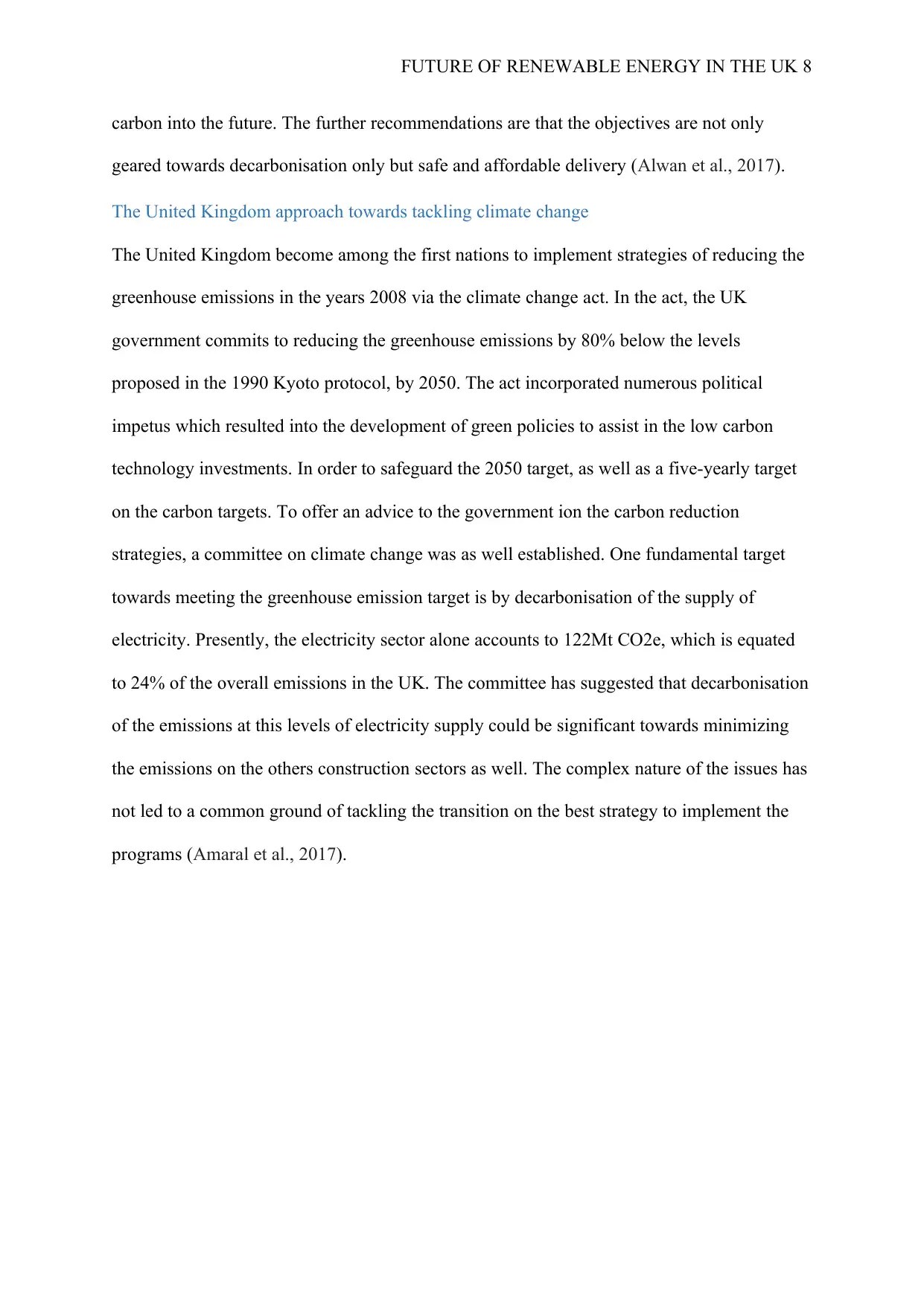
FUTURE OF RENEWABLE ENERGY IN THE UK 8
carbon into the future. The further recommendations are that the objectives are not only
geared towards decarbonisation only but safe and affordable delivery (Alwan et al., 2017).
The United Kingdom approach towards tackling climate change
The United Kingdom become among the first nations to implement strategies of reducing the
greenhouse emissions in the years 2008 via the climate change act. In the act, the UK
government commits to reducing the greenhouse emissions by 80% below the levels
proposed in the 1990 Kyoto protocol, by 2050. The act incorporated numerous political
impetus which resulted into the development of green policies to assist in the low carbon
technology investments. In order to safeguard the 2050 target, as well as a five-yearly target
on the carbon targets. To offer an advice to the government ion the carbon reduction
strategies, a committee on climate change was as well established. One fundamental target
towards meeting the greenhouse emission target is by decarbonisation of the supply of
electricity. Presently, the electricity sector alone accounts to 122Mt CO2e, which is equated
to 24% of the overall emissions in the UK. The committee has suggested that decarbonisation
of the emissions at this levels of electricity supply could be significant towards minimizing
the emissions on the others construction sectors as well. The complex nature of the issues has
not led to a common ground of tackling the transition on the best strategy to implement the
programs (Amaral et al., 2017).
carbon into the future. The further recommendations are that the objectives are not only
geared towards decarbonisation only but safe and affordable delivery (Alwan et al., 2017).
The United Kingdom approach towards tackling climate change
The United Kingdom become among the first nations to implement strategies of reducing the
greenhouse emissions in the years 2008 via the climate change act. In the act, the UK
government commits to reducing the greenhouse emissions by 80% below the levels
proposed in the 1990 Kyoto protocol, by 2050. The act incorporated numerous political
impetus which resulted into the development of green policies to assist in the low carbon
technology investments. In order to safeguard the 2050 target, as well as a five-yearly target
on the carbon targets. To offer an advice to the government ion the carbon reduction
strategies, a committee on climate change was as well established. One fundamental target
towards meeting the greenhouse emission target is by decarbonisation of the supply of
electricity. Presently, the electricity sector alone accounts to 122Mt CO2e, which is equated
to 24% of the overall emissions in the UK. The committee has suggested that decarbonisation
of the emissions at this levels of electricity supply could be significant towards minimizing
the emissions on the others construction sectors as well. The complex nature of the issues has
not led to a common ground of tackling the transition on the best strategy to implement the
programs (Amaral et al., 2017).
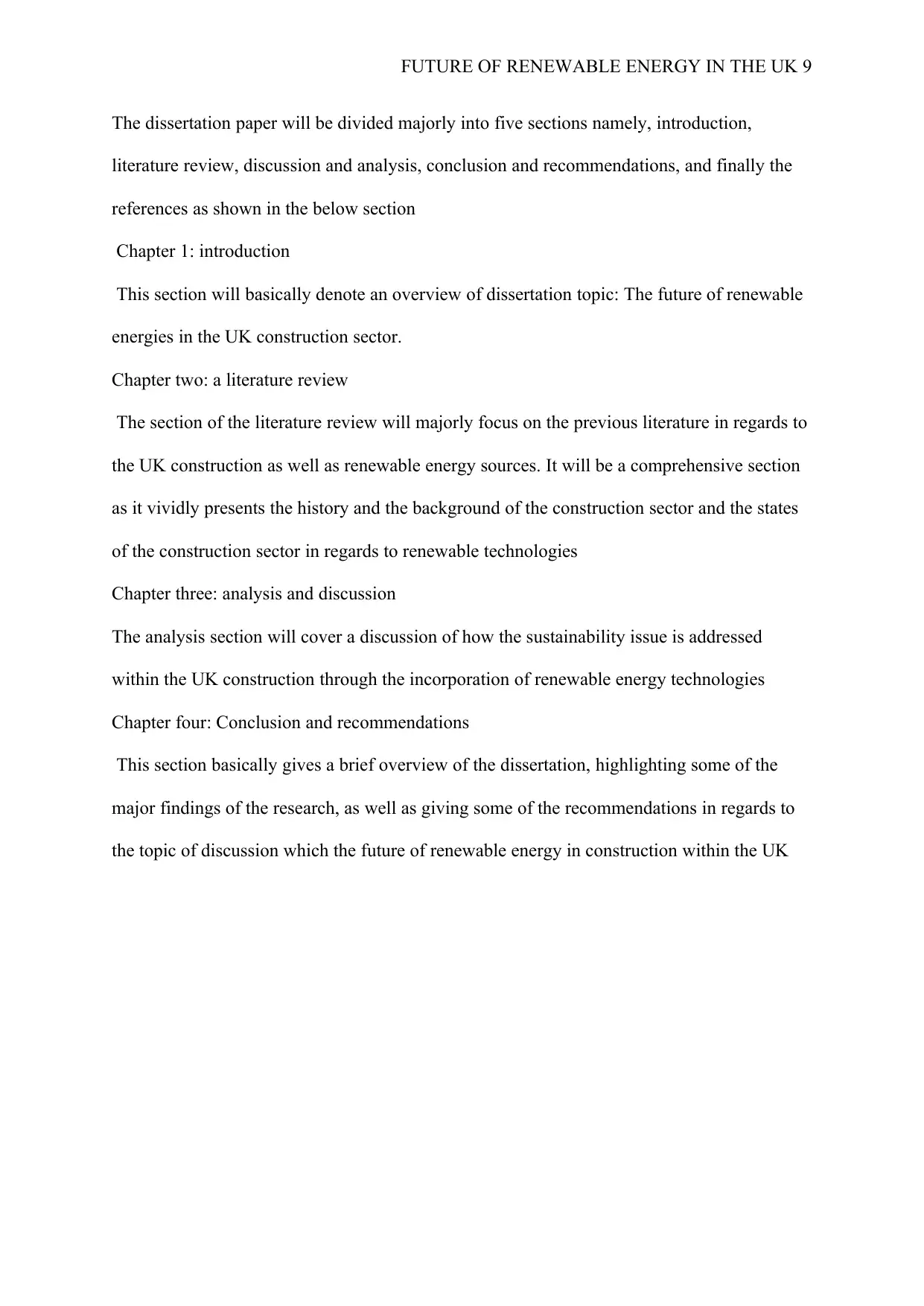
FUTURE OF RENEWABLE ENERGY IN THE UK 9
The dissertation paper will be divided majorly into five sections namely, introduction,
literature review, discussion and analysis, conclusion and recommendations, and finally the
references as shown in the below section
Chapter 1: introduction
This section will basically denote an overview of dissertation topic: The future of renewable
energies in the UK construction sector.
Chapter two: a literature review
The section of the literature review will majorly focus on the previous literature in regards to
the UK construction as well as renewable energy sources. It will be a comprehensive section
as it vividly presents the history and the background of the construction sector and the states
of the construction sector in regards to renewable technologies
Chapter three: analysis and discussion
The analysis section will cover a discussion of how the sustainability issue is addressed
within the UK construction through the incorporation of renewable energy technologies
Chapter four: Conclusion and recommendations
This section basically gives a brief overview of the dissertation, highlighting some of the
major findings of the research, as well as giving some of the recommendations in regards to
the topic of discussion which the future of renewable energy in construction within the UK
The dissertation paper will be divided majorly into five sections namely, introduction,
literature review, discussion and analysis, conclusion and recommendations, and finally the
references as shown in the below section
Chapter 1: introduction
This section will basically denote an overview of dissertation topic: The future of renewable
energies in the UK construction sector.
Chapter two: a literature review
The section of the literature review will majorly focus on the previous literature in regards to
the UK construction as well as renewable energy sources. It will be a comprehensive section
as it vividly presents the history and the background of the construction sector and the states
of the construction sector in regards to renewable technologies
Chapter three: analysis and discussion
The analysis section will cover a discussion of how the sustainability issue is addressed
within the UK construction through the incorporation of renewable energy technologies
Chapter four: Conclusion and recommendations
This section basically gives a brief overview of the dissertation, highlighting some of the
major findings of the research, as well as giving some of the recommendations in regards to
the topic of discussion which the future of renewable energy in construction within the UK
⊘ This is a preview!⊘
Do you want full access?
Subscribe today to unlock all pages.

Trusted by 1+ million students worldwide
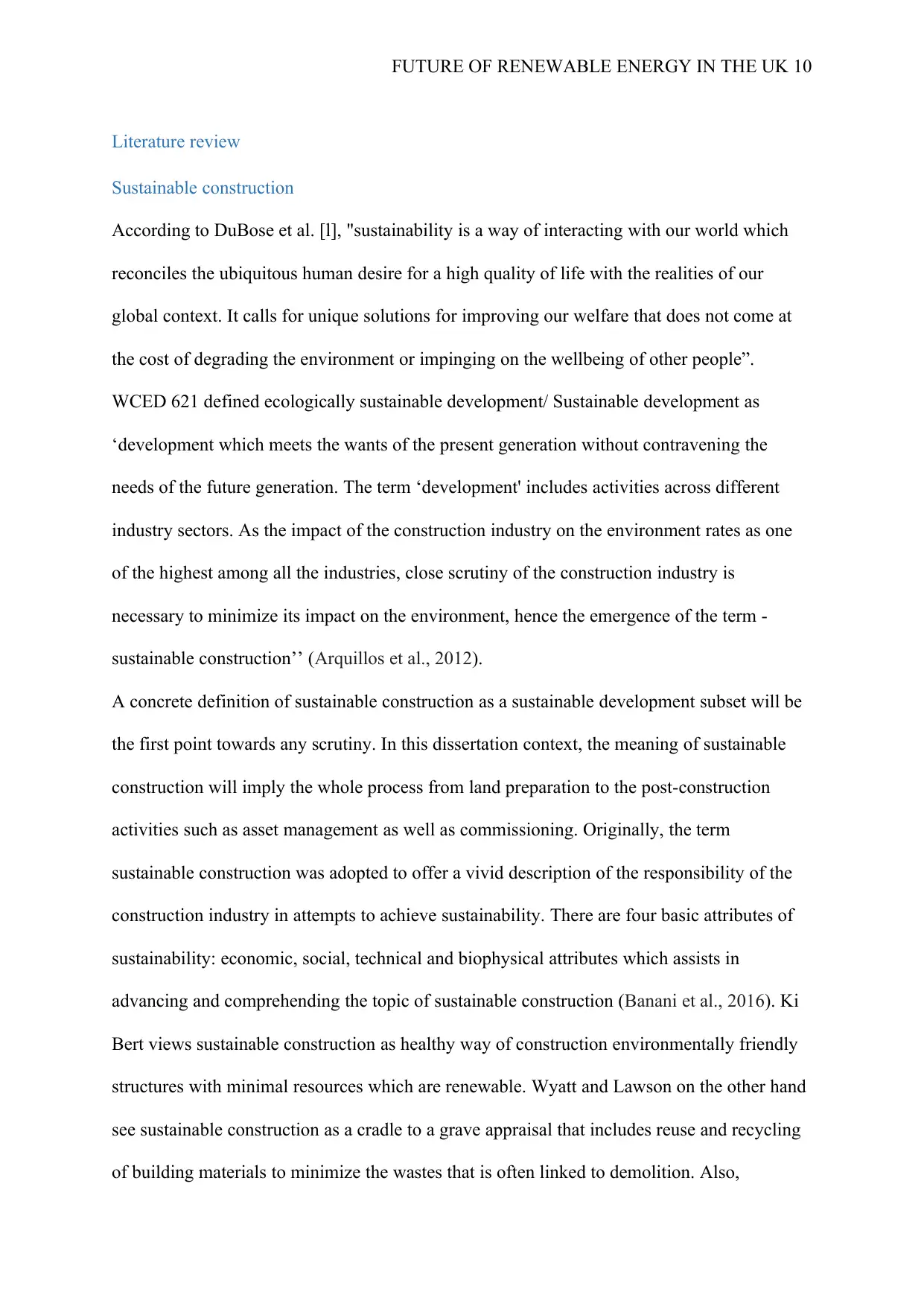
FUTURE OF RENEWABLE ENERGY IN THE UK 10
Literature review
Sustainable construction
According to DuBose et al. [l], "sustainability is a way of interacting with our world which
reconciles the ubiquitous human desire for a high quality of life with the realities of our
global context. It calls for unique solutions for improving our welfare that does not come at
the cost of degrading the environment or impinging on the wellbeing of other people”.
WCED 621 defined ecologically sustainable development/ Sustainable development as
‘development which meets the wants of the present generation without contravening the
needs of the future generation. The term ‘development' includes activities across different
industry sectors. As the impact of the construction industry on the environment rates as one
of the highest among all the industries, close scrutiny of the construction industry is
necessary to minimize its impact on the environment, hence the emergence of the term -
sustainable construction’’ (Arquillos et al., 2012).
A concrete definition of sustainable construction as a sustainable development subset will be
the first point towards any scrutiny. In this dissertation context, the meaning of sustainable
construction will imply the whole process from land preparation to the post-construction
activities such as asset management as well as commissioning. Originally, the term
sustainable construction was adopted to offer a vivid description of the responsibility of the
construction industry in attempts to achieve sustainability. There are four basic attributes of
sustainability: economic, social, technical and biophysical attributes which assists in
advancing and comprehending the topic of sustainable construction (Banani et al., 2016). Ki
Bert views sustainable construction as healthy way of construction environmentally friendly
structures with minimal resources which are renewable. Wyatt and Lawson on the other hand
see sustainable construction as a cradle to a grave appraisal that includes reuse and recycling
of building materials to minimize the wastes that is often linked to demolition. Also,
Literature review
Sustainable construction
According to DuBose et al. [l], "sustainability is a way of interacting with our world which
reconciles the ubiquitous human desire for a high quality of life with the realities of our
global context. It calls for unique solutions for improving our welfare that does not come at
the cost of degrading the environment or impinging on the wellbeing of other people”.
WCED 621 defined ecologically sustainable development/ Sustainable development as
‘development which meets the wants of the present generation without contravening the
needs of the future generation. The term ‘development' includes activities across different
industry sectors. As the impact of the construction industry on the environment rates as one
of the highest among all the industries, close scrutiny of the construction industry is
necessary to minimize its impact on the environment, hence the emergence of the term -
sustainable construction’’ (Arquillos et al., 2012).
A concrete definition of sustainable construction as a sustainable development subset will be
the first point towards any scrutiny. In this dissertation context, the meaning of sustainable
construction will imply the whole process from land preparation to the post-construction
activities such as asset management as well as commissioning. Originally, the term
sustainable construction was adopted to offer a vivid description of the responsibility of the
construction industry in attempts to achieve sustainability. There are four basic attributes of
sustainability: economic, social, technical and biophysical attributes which assists in
advancing and comprehending the topic of sustainable construction (Banani et al., 2016). Ki
Bert views sustainable construction as healthy way of construction environmentally friendly
structures with minimal resources which are renewable. Wyatt and Lawson on the other hand
see sustainable construction as a cradle to a grave appraisal that includes reuse and recycling
of building materials to minimize the wastes that is often linked to demolition. Also,
Paraphrase This Document
Need a fresh take? Get an instant paraphrase of this document with our AI Paraphraser
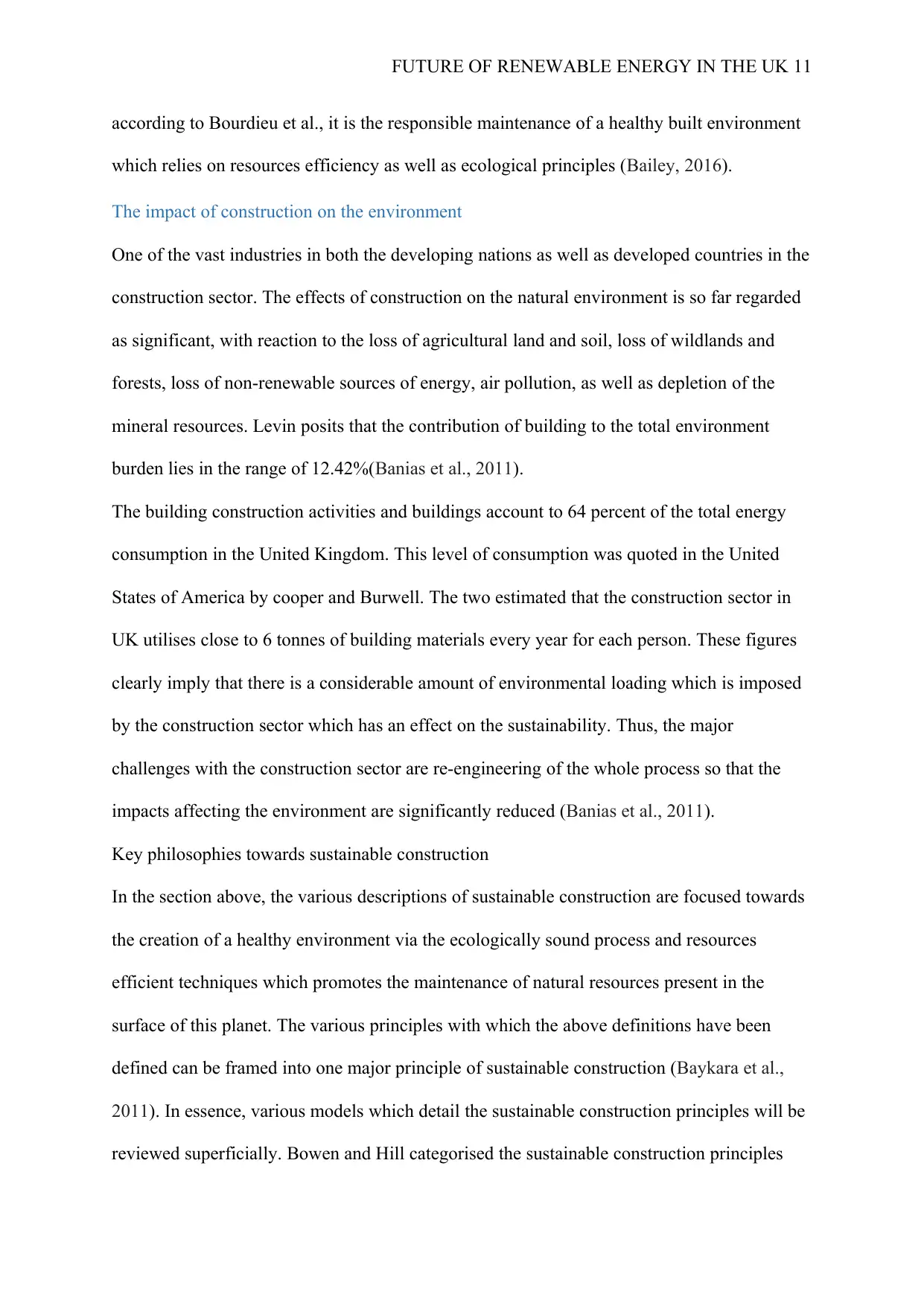
FUTURE OF RENEWABLE ENERGY IN THE UK 11
according to Bourdieu et al., it is the responsible maintenance of a healthy built environment
which relies on resources efficiency as well as ecological principles (Bailey, 2016).
The impact of construction on the environment
One of the vast industries in both the developing nations as well as developed countries in the
construction sector. The effects of construction on the natural environment is so far regarded
as significant, with reaction to the loss of agricultural land and soil, loss of wildlands and
forests, loss of non-renewable sources of energy, air pollution, as well as depletion of the
mineral resources. Levin posits that the contribution of building to the total environment
burden lies in the range of 12.42%(Banias et al., 2011).
The building construction activities and buildings account to 64 percent of the total energy
consumption in the United Kingdom. This level of consumption was quoted in the United
States of America by cooper and Burwell. The two estimated that the construction sector in
UK utilises close to 6 tonnes of building materials every year for each person. These figures
clearly imply that there is a considerable amount of environmental loading which is imposed
by the construction sector which has an effect on the sustainability. Thus, the major
challenges with the construction sector are re-engineering of the whole process so that the
impacts affecting the environment are significantly reduced (Banias et al., 2011).
Key philosophies towards sustainable construction
In the section above, the various descriptions of sustainable construction are focused towards
the creation of a healthy environment via the ecologically sound process and resources
efficient techniques which promotes the maintenance of natural resources present in the
surface of this planet. The various principles with which the above definitions have been
defined can be framed into one major principle of sustainable construction (Baykara et al.,
2011). In essence, various models which detail the sustainable construction principles will be
reviewed superficially. Bowen and Hill categorised the sustainable construction principles
according to Bourdieu et al., it is the responsible maintenance of a healthy built environment
which relies on resources efficiency as well as ecological principles (Bailey, 2016).
The impact of construction on the environment
One of the vast industries in both the developing nations as well as developed countries in the
construction sector. The effects of construction on the natural environment is so far regarded
as significant, with reaction to the loss of agricultural land and soil, loss of wildlands and
forests, loss of non-renewable sources of energy, air pollution, as well as depletion of the
mineral resources. Levin posits that the contribution of building to the total environment
burden lies in the range of 12.42%(Banias et al., 2011).
The building construction activities and buildings account to 64 percent of the total energy
consumption in the United Kingdom. This level of consumption was quoted in the United
States of America by cooper and Burwell. The two estimated that the construction sector in
UK utilises close to 6 tonnes of building materials every year for each person. These figures
clearly imply that there is a considerable amount of environmental loading which is imposed
by the construction sector which has an effect on the sustainability. Thus, the major
challenges with the construction sector are re-engineering of the whole process so that the
impacts affecting the environment are significantly reduced (Banias et al., 2011).
Key philosophies towards sustainable construction
In the section above, the various descriptions of sustainable construction are focused towards
the creation of a healthy environment via the ecologically sound process and resources
efficient techniques which promotes the maintenance of natural resources present in the
surface of this planet. The various principles with which the above definitions have been
defined can be framed into one major principle of sustainable construction (Baykara et al.,
2011). In essence, various models which detail the sustainable construction principles will be
reviewed superficially. Bowen and Hill categorised the sustainable construction principles
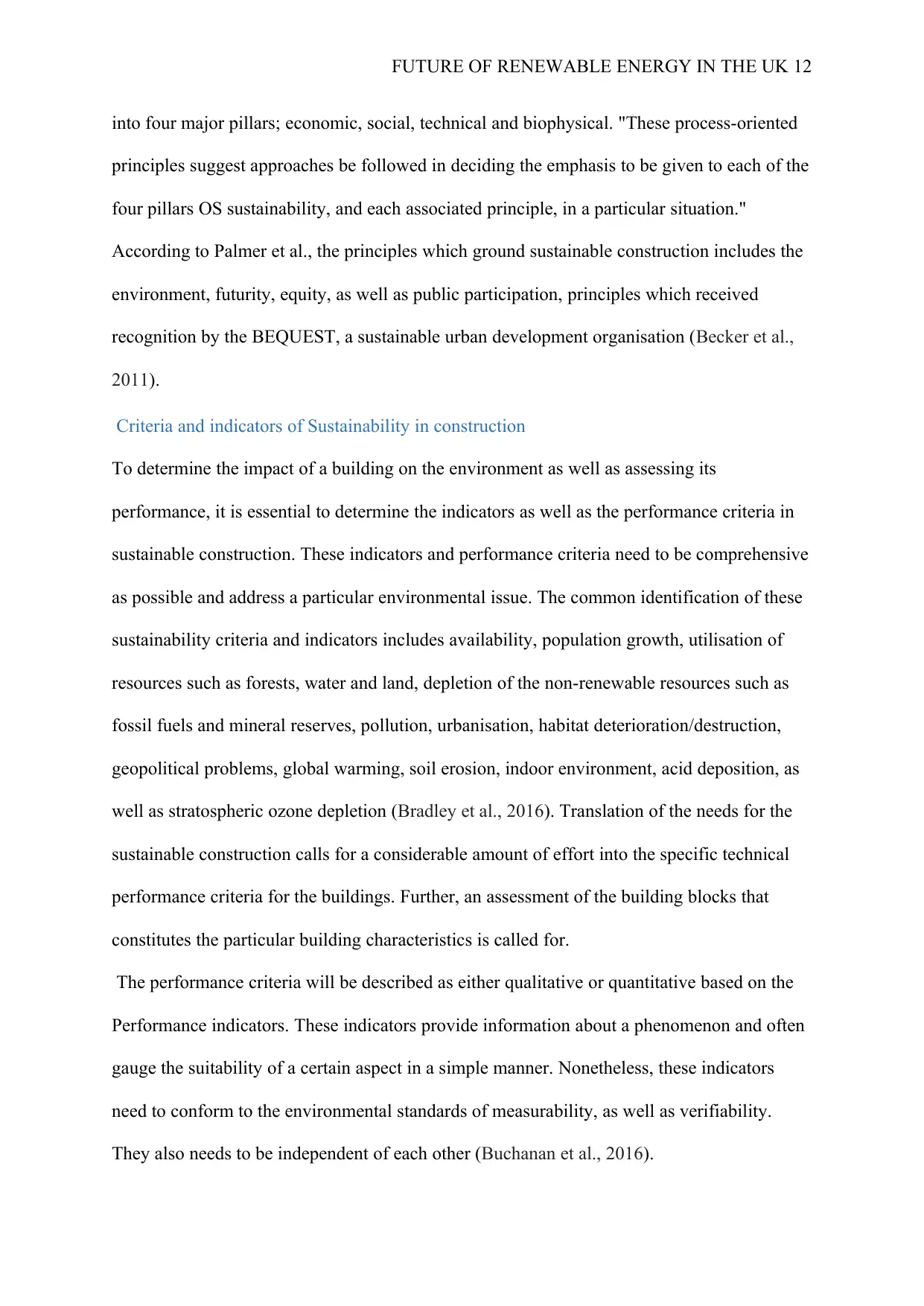
FUTURE OF RENEWABLE ENERGY IN THE UK 12
into four major pillars; economic, social, technical and biophysical. "These process-oriented
principles suggest approaches be followed in deciding the emphasis to be given to each of the
four pillars OS sustainability, and each associated principle, in a particular situation."
According to Palmer et al., the principles which ground sustainable construction includes the
environment, futurity, equity, as well as public participation, principles which received
recognition by the BEQUEST, a sustainable urban development organisation (Becker et al.,
2011).
Criteria and indicators of Sustainability in construction
To determine the impact of a building on the environment as well as assessing its
performance, it is essential to determine the indicators as well as the performance criteria in
sustainable construction. These indicators and performance criteria need to be comprehensive
as possible and address a particular environmental issue. The common identification of these
sustainability criteria and indicators includes availability, population growth, utilisation of
resources such as forests, water and land, depletion of the non-renewable resources such as
fossil fuels and mineral reserves, pollution, urbanisation, habitat deterioration/destruction,
geopolitical problems, global warming, soil erosion, indoor environment, acid deposition, as
well as stratospheric ozone depletion (Bradley et al., 2016). Translation of the needs for the
sustainable construction calls for a considerable amount of effort into the specific technical
performance criteria for the buildings. Further, an assessment of the building blocks that
constitutes the particular building characteristics is called for.
The performance criteria will be described as either qualitative or quantitative based on the
Performance indicators. These indicators provide information about a phenomenon and often
gauge the suitability of a certain aspect in a simple manner. Nonetheless, these indicators
need to conform to the environmental standards of measurability, as well as verifiability.
They also needs to be independent of each other (Buchanan et al., 2016).
into four major pillars; economic, social, technical and biophysical. "These process-oriented
principles suggest approaches be followed in deciding the emphasis to be given to each of the
four pillars OS sustainability, and each associated principle, in a particular situation."
According to Palmer et al., the principles which ground sustainable construction includes the
environment, futurity, equity, as well as public participation, principles which received
recognition by the BEQUEST, a sustainable urban development organisation (Becker et al.,
2011).
Criteria and indicators of Sustainability in construction
To determine the impact of a building on the environment as well as assessing its
performance, it is essential to determine the indicators as well as the performance criteria in
sustainable construction. These indicators and performance criteria need to be comprehensive
as possible and address a particular environmental issue. The common identification of these
sustainability criteria and indicators includes availability, population growth, utilisation of
resources such as forests, water and land, depletion of the non-renewable resources such as
fossil fuels and mineral reserves, pollution, urbanisation, habitat deterioration/destruction,
geopolitical problems, global warming, soil erosion, indoor environment, acid deposition, as
well as stratospheric ozone depletion (Bradley et al., 2016). Translation of the needs for the
sustainable construction calls for a considerable amount of effort into the specific technical
performance criteria for the buildings. Further, an assessment of the building blocks that
constitutes the particular building characteristics is called for.
The performance criteria will be described as either qualitative or quantitative based on the
Performance indicators. These indicators provide information about a phenomenon and often
gauge the suitability of a certain aspect in a simple manner. Nonetheless, these indicators
need to conform to the environmental standards of measurability, as well as verifiability.
They also needs to be independent of each other (Buchanan et al., 2016).
⊘ This is a preview!⊘
Do you want full access?
Subscribe today to unlock all pages.

Trusted by 1+ million students worldwide
1 out of 57
Related Documents
Your All-in-One AI-Powered Toolkit for Academic Success.
+13062052269
info@desklib.com
Available 24*7 on WhatsApp / Email
![[object Object]](/_next/static/media/star-bottom.7253800d.svg)
Unlock your academic potential
Copyright © 2020–2025 A2Z Services. All Rights Reserved. Developed and managed by ZUCOL.





